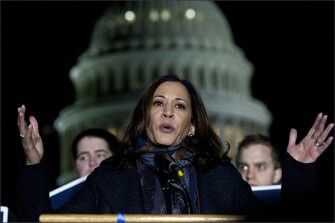
Democratic presidential contender Sen. Kamala Harris’ said last weekend that, if elected, , according to the campaign. For context: That would be about a 23 percent increase in base pay for the average teacher. In Harris’ view, it would help make up for the fact that public school teachers make 11 percent less than similar professionals with college degrees. (That’s according to a report by the Economic Policy Institute, a left-leaning think tank.)
“We must acknowledge this simple truth: We are a country that claims to care about education, but not so much about the education of other people’s children,” . “At the most fundamental level, our children are being raised by two groups of people: families and teachers. Yet, we fail to pay teachers their value.”
So how would Harris actually accomplish this? Here’s her plan.
- The U.S. Department of Education would work with state education agencies to set a base salary goal for beginning teachers in each state. States would increase every teacher’s salary until they met that goal.
- The federal government would pay up front 10 percent of the cost of reaching that salary goal.
- After that initial up-front payment, the feds would match $3 for every $1 the state contributes. That means this plan would depend in part on states’ willingness to participate.
There would be extra resources to help boost pay in the highest-need schools, which serve a disproportionate share of children of color, the Harris campaign says. There are no specifics yet on how the plan would define “highest-need.”
And there would be additional funding—"billions”, according to the campaign—to help support and train teachers, through things like teacher and principal residencies, mentoring and induction programs for new teachers, and programs to help encourage teacher diversity.
Half of this teacher-training funding would go to minority-serving institutions, such as historically black colleges and universities. Studies have shown that students of color can benefit from having teachers of color. ()
Randi Weingarten, the president of the American Federation of Teachers, praised the proposal.
“Sen. Harris’ plan is a bold, smart, strategic and decisive proposal that will help make teaching a respected profession by paying teachers a living wage, while incentivizing diversity and high-quality teacher preparation,” she said. “It will help fund our future by delivering urgently needed help to communities wracked by decades of austerity and underinvestment.”
What’s the cost of this plan? The Harris campaign is estimating a price tag of $315 billion over ten years. It would be paid for by making changes to the estate tax, and closing tax loopholes, the Harris campaign says.
There are still unanswered questions. For instance, Harris’ proposal also doesn’t specify how, or whether, teachers in different subjects or with varying levels of experience might be impacted differently.
Could this actually pass? It’s hard to imagine the proposal as written getting very far in the current political landscape, given that Republicans control the Senate. It wasn’t easy for the Obama administration to get just $10 billion to save teachers’ jobs at the height of the Great Recession, and that was when Democrats controlled both chambers of Congress.
But a less-sweeping version of the proposal—or some other push on teacher pay—could garner bipartisan support, as the issue has in some states.
Photo: Sen. Kamala Harris, D-Calif., in front of the U.S. Capitol. (Jose Luis Magana for the Associated Press)
